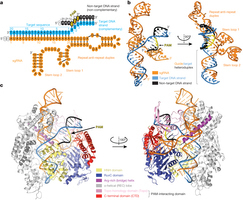A major challenge of CRISPR/Cas9-mediated genome engineering is that not all guide RNAs (gRNAs) cleave the DNA efficiently. Although the heterogeneity of gRNA activity is well recognized, the current understanding of how CRISPR/Cas9 activity is regulated remains incomplete. Here, we identify a sweet spot range of binding free energy change for optimal efficiency which largely explains why gRNAs display changes in efficiency at on- and off-target sites, including why gRNAs can cleave an off-target with higher efficiency than the on-target. Using an energy-based model, we show that local gRNA-DNA interactions resulting from Cas9 “sliding” on overlapping protospacer adjacent motifs (PAMs) profoundly impact gRNA activities. Combining the effects of local sliding for a given PAM context with global off-targets allows us to better identify highly specific, and thus efficient, gRNAs. We validate the effects of local sliding on gRNA efficiency using both public data and in-house data generated by measuring SpCas9 cleavage efficiency at 1024 sites designed to cover all possible combinations of 4-nt PAM and context sequences of 4 gRNAs. Our results provide insights into the mechanisms of Cas9-PAM compatibility and cleavage activation, underlining the importance of accounting for local sliding in gRNA design. CRISPR/Cas9-mediated cleavage efficiency varies at different target locations. Here the authors explain this variation with binding free energy changes and show that overlapping Cas9 binding sites influence cleavage efficiency by enabling Cas9 sliding.
Research and publish the best content.
Get Started for FREE
Sign up with Facebook Sign up with X
I don't have a Facebook or a X account
Already have an account: Login
 Your new post is loading... Your new post is loading...
 Your new post is loading... Your new post is loading...
|
|





















A major drawback of CRISPR-Cas9-mediated genome editing is that not all guide RNAs (gRNAs) efficiently cleave target DNA. Although the heterogeneity of gRNA activity is well recognized, the exact way in which CRISPR-Cas9 activity is regulated is not fully understood. In a recent study, a team of researchers used an energy-based model to identify the mechanisms regulating CRISPR-Cas9 activity and specificity. The team investigated the binding free energy, Δ G H , of RNA-DNA interactions and the effects of energy changes during RNA-DNA hybridisation on the efficiency of 11,602 Cas9 gRNAs experimentally validated in other studies. The efficiency of the gRNAs was measured as indel frequency, which is the most accurate indicator of CRISPR-Cas9 activity. They found that Cas9 'slippage' or binding competition on adjacent overlapping protospacer motifs (PAMs) affected gRNA activity by regulating local RNA-DNA interactions. Furthermore, the binding free energy sweet spot quantitatively defines the optimal activity of CRISPR-Cas9 at target and off-target sites in that the gRNA does not bind too weakly or too strongly. In the future, the team will continue to improve their methods, which will include further optimization of the gRNA design for increased efficiency and specificity.